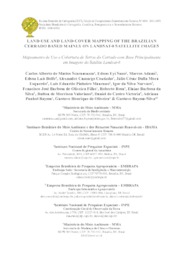Land-use and land-cover mapping of the Brazilian cerrado based mainly on Landsat-8 satellite images.
Land-use and land-cover mapping of the Brazilian cerrado based mainly on Landsat-8 satellite images.
Author(s): SCARAMUZZA, C. A. de M.; SANO, E. E.; ADAMI, M.; BOLFE, E. L.; COUTINHO, A. C.; ESQUERDO, J. C. D. M.; MAURANO, L. E. P.; NARVAES, I. da S.; OLIVEIRA FILHO, F. J. B. de; ROSA, R.; SILVA, E. B. da; VALERIANO, D. de M.; VICTORIA, D. de C.; BAYMA, A. P.; OLIVEIRA, G. H. de; SILVA, G. B. S. da
Summary: The Brazilian Cerrado is one of the world´s biodiversity hotspot and hosts some of the most intensive agricultural activities for food production in the world. The objective of this study was to produce a land-use and land-cover (LULC) map of the Cerrado based on Landsat-8 Operational Land Imager (OLI) images. A set of 121 scenes from 2013 was processed using the image segmentation technique. The segments were exported in the shapefile format and interpreted visually in a geographical information system software using RGB/564 color composites. The following LULC classes were considered: annual croplands, perennial croplands, cultivated pasturelands, reforestation, mosaic of occupation, urban areas, mining areas, bare soil, forestlands, non-forestlands, water bodies, and non-identified (clouds and burned areas). The overall accuracy was estimated by an independent scientist with large experience in Cerrado´s image interpretation. The results showed that 43.4% of the study area (88.5 million hectares) were already converted into agricultural, urban and mining areas, 54.6% (111 million hectares) were still natural areas, and 1.9% (3.9 million hectares) was classified as non-identified. Cultivated pasturelands were the most representative land-use type (29.5%), followed by annual croplands (8.5%) and perennial croplands (3.1%). The overall accuracy of the final map was 80.2%.
Publication year: 2017
Types of publication: Journal article
Observation
Some of Embrapa's publications are published as ePub files. To read them, use or download one of the following free software options to your computer or mobile device. Android: Google Play Books; IOS: iBooks; Windows and Linux: Calibre.
Access other publications
Access the Agricultural Research Database (BDPA) to consult Embrapa's full library collection and records.
Visit Embrapa Bookstore to purchase books and other publications sold by Embrapa.

